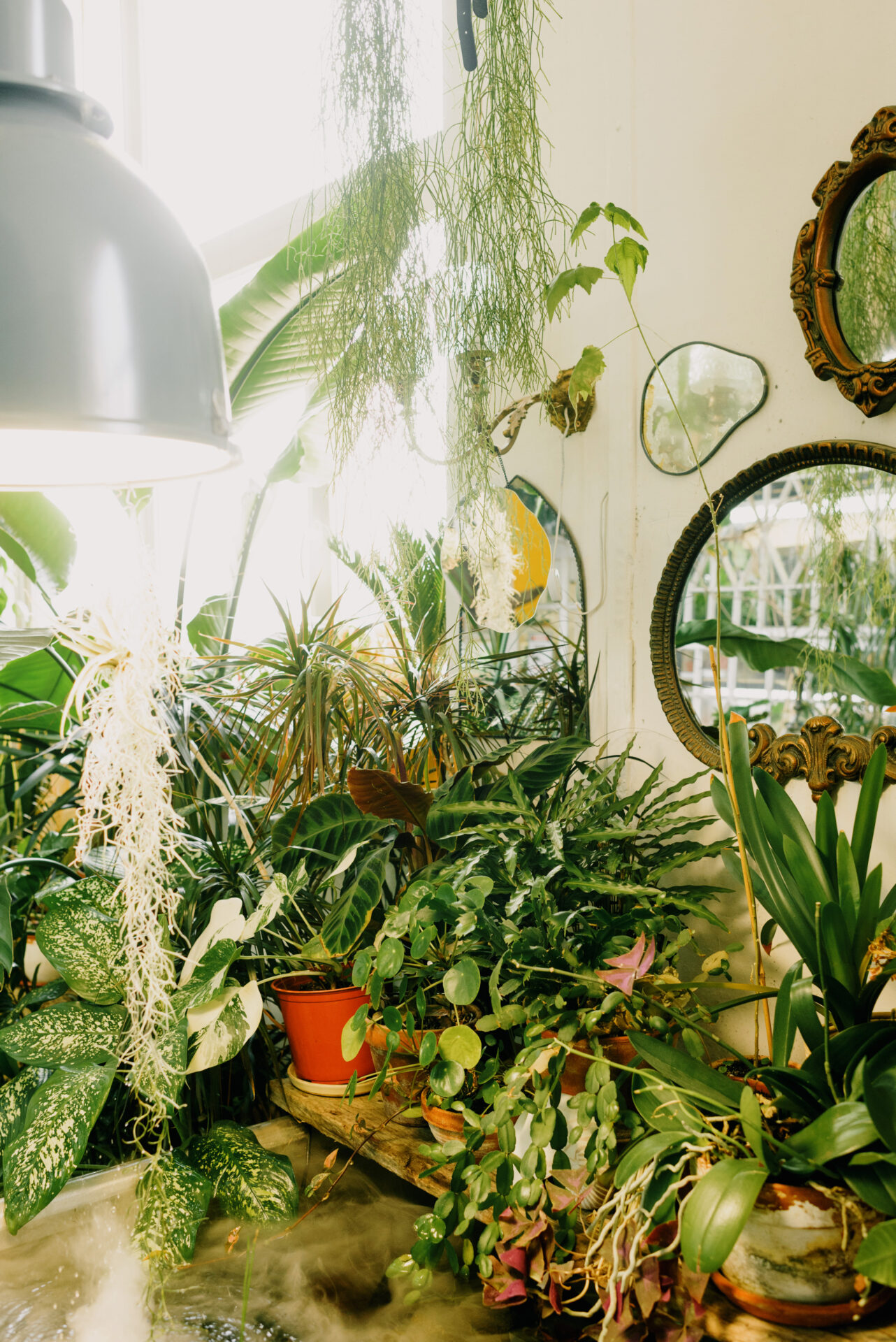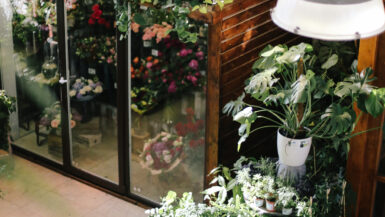Indoor vertical gardening is an innovative and increasingly popular method of growing plants in urban environments or where space is limited. This approach maximizes vertical space and allows more plants to be grown in a smaller area, making it an ideal choice for city dwellers and those with limited outdoor areas.
This article will delve into the essential vertical garden tools required for a successful indoor vertical garden. We will explore the various types of vertical garden systems, the importance of proper lighting and irrigation, and the best practices for maintaining optimal plant health. Equipping yourself with the right tools and knowledge can transform your indoor space into a thriving green oasis.
Top Lighting Solutions for Indoor Vertical Gardens
Lighting is crucial to successful indoor vertical gardening, as it directly affects your plants’ health, growth, and productivity. In this subsection, we will explore various lighting solutions that cater to different gardening needs and preferences. We have covered you, from energy-efficient LED grow lights to natural sunlight-mimicking options. To further enhance your indoor vertical garden, consider checking out our office indoor vertical garden ideas to elevate your workspace aesthetics.
LED Grow Lights: Energy Efficiency Meets Horticulture
LED grow lights are an excellent choice for indoor vertical gardens due to their energy efficiency and customizable light spectrums. These lights emit less heat, reducing the risk of damaging your plants and allowing for closer placement. Furthermore, they can be tailored to provide the specific wavelengths of light needed for optimal plant growth, ensuring that your greenery receives the precise nourishment it requires.
Fluorescent Lights: A Budget-Friendly Alternative
Fluorescent lights, such as T5 and compact fluorescent lamps (CFLs), are cost-effective for indoor vertical gardens. They provide a broad light spectrum, resembling natural sunlight, and are suitable for various plants, including leafy greens and small fruiting plants. However, they may require bulb replacements more frequently than LED grow lights.
High-Intensity Discharge (HID) Lights: For Larger Indoor Gardens
High-intensity discharge (HID) lights, such as metal halide (MH) and high-pressure sodium (HPS) lamps, are suitable for larger-scale indoor vertical gardens or those with higher light requirements. These lights emit an intense light output, promoting vigorous plant growth. However, they can produce substantial heat and consume more energy compared to LED and fluorescent lights. Adequate ventilation and proper light placement are crucial to prevent plant damage.
Light Movers: Maximize Light Distribution and Efficiency
Light movers are mechanical devices that move grow lights along a predetermined path, ensuring even light distribution across your indoor vertical garden. By investing in light movers, you can maximize the efficiency of your lighting setup and reduce the number of lights needed. Light movers are compatible with various light types, making them a versatile addition to your indoor garden toolkit.
With knowledge of these top lighting solutions, you can choose the best indoor vertical garden option. Your plants will flourish with the proper light setup, transforming your space into a vibrant, green sanctuary.
Maintaining and Troubleshooting Indoor Vertical Gardens
This subsection will delve into the essential maintenance practices and troubleshooting tips for keeping your indoor vertical garden thriving. Indoor vertical gardening success relies on consistent care and the ability to address any issues that may arise. By staying proactive and informed, you can ensure the longevity and health of your garden, reaping the benefits of a green and vibrant space.
Proper Watering and Irrigation Techniques
Providing the right amount of water is key to maintaining your indoor vertical garden’s health. Over- or underwatering can lead to plant stress, diseases, and even death. To avoid these issues, consider investing in an automated drip irrigation system that delivers the correct amount of water to each plant. Alternatively, if you prefer a more hands-on approach, monitor soil moisture levels and water your plants accordingly, ensuring they never dry out or become waterlogged.
Regular Pruning and Plant Care
Regular pruning and plant care are crucial for maintaining the aesthetics and functionality of your indoor vertical garden. Remove dead or diseased leaves, trim overgrown branches or vines, and check for pests or other problems. This promotes healthy plant growth and helps prevent the spread of diseases and pests.
Fertilization and Nutrient Management
Indoor vertical gardens require regular fertilization to ensure optimal plant growth and development. Use a balanced, slow-release fertilizer to give your plants the necessary nutrients. Be cautious not to over-fertilize, as this can lead to nutrient imbalances and harm your plants. Additionally, watch for signs of nutrient deficiencies, such as yellowing leaves or stunted growth, and adjust your fertilization regimen accordingly.
Troubleshooting Common Issues
Even with proper maintenance, your indoor vertical garden may encounter issues from time to time. Please familiarize yourself with common problems and their solutions so that you can address them quickly and effectively. Common topics include pests, diseases, and environmental stressors such as inadequate lighting or temperature fluctuations. By promptly identifying these issues and implementing appropriate solutions, you can minimize their impact on your garden and maintain a healthy, thriving space.
Rotation of Plant Species
Rotating plant species within your indoor vertical garden can help prevent the build-up of pests and diseases while promoting a diverse and visually appealing environment. By periodically changing the arrangement of your plants, you can also ensure that each plant receives adequate light and nutrients.
With these maintenance and troubleshooting tips, you can confidently care for your indoor vertical garden and enjoy its numerous benefits. A well-maintained garden will enhance your living space and testify to your dedication and passion for urban horticulture.
Indoor Vertical Gardening Basics for Beginners
Embarking on your indoor vertical gardening journey can be both exciting and daunting. To set you up for success, we will cover the fundamentals of this innovative gardening method. This subsection will introduce you to various indoor vertical garden systems, the importance of selecting suitable plants, and the basic care requirements for a flourishing garden. By familiarizing yourself with these concepts, you can create a strong foundation for indoor vertical gardening pursuits.
Choosing the Right Vertical Garden System
Numerous indoor vertical garden systems are available, each catering to different needs and preferences. Here are some popular options to consider:
– Wall-mounted systems: These systems are directly attached to a wall through brackets or a modular panel. They are ideal for those with limited floor space and can create a stunning living wall effect.
– Freestanding systems: Freestanding vertical gardens are self-contained units that can be easily moved and repositioned. They often come with built-in irrigation systems and are perfect for those seeking flexibility and ease of use.
– Shelving systems: Shelving systems utilize tiered shelves to accommodate potted plants, allowing easy access and care. This option is ideal for those who prefer a more traditional gardening approach but want to maximize vertical space.
Evaluate your specific needs and preferences to determine the most suitable indoor vertical garden system.
Selecting Suitable Plants for Your Indoor Vertical Garden
Choosing the right plants is crucial for a thriving indoor vertical garden. Consider the following factors when selecting your plants:
– Light requirements: Ensure that the plants you choose are well-suited to the available light in your space. Some plants require bright, direct sunlight, while others thrive in low-light conditions.
– Size and growth habits: Select plants with appropriate size and growth habits to avoid overcrowding and ensure a visually appealing arrangement.
– Maintenance needs: Opt for plants with similar care requirements to simplify maintenance and ensure consistent conditions across your garden.
Some popular choices for indoor vertical gardens include ferns, pothos, spider plants, and various herbs and leafy greens.
Basic Care Requirements for Indoor Vertical Gardens
To keep your indoor vertical garden thriving, it is essential to provide consistent care and attention. Here are some basic care requirements to keep in mind:
Watering: Monitor your plants’ moisture levels and water them as needed, taking care not to overwater or drown them. Consider investing in an automated irrigation system for consistent and efficient watering.
Lighting: Ensure your plants receive adequate light by using suitable grow lights or positioning your garden near a natural light source.
Nutrition: Use a balanced, slow-release fertilizer to give your plants nutrients. Be mindful of over-fertilizing, as this can harm your plants.
Pest and disease control: Look for signs of pests and diseases and address any issues promptly to prevent them from spreading.
By mastering these indoor vertical gardening basics, you will be well on your way to creating a thriving, vibrant oasis in your home. As you gain experience and confidence, you can further explore advanced techniques and tools to elevate your garden to new heights.
Choosing the Best Vertical Garden Systems
Success in indoor vertical gardening largely depends on selecting the right system that caters to your needs, preferences, and space constraints. This subsection will explore various vertical garden systems that offer unique features and benefits. Understanding the key differences between these systems lets you decide which option best suits your indoor gardening goals.
Modular Living Wall Systems: A Stylish and Flexible Option
Modular living wall systems comprise individual plant containers easily mounted on a wall, creating a stunning and customizable green display. These systems offer flexibility in plant arrangement, allowing you to make your unique design or quickly change the layout as your garden evolves. Furthermore, they often come with integrated irrigation systems, ensuring that your plants receive the optimal water.
Vertical Pocket Planters: Space-Saving and Versatile
Vertical pocket planters consist of fabric or felt pockets attached to a wall or a freestanding frame. These systems are ideal for those with limited space, as they can easily be scaled up or down to fit your needs. The pockets are perfect for growing various plants, from herbs and leafy greens to ornamental flowers or succulents. Additionally, the breathable material allows for excellent drainage and root aeration, promoting healthy plant growth.
Hydroponic Vertical Gardens: A Soil-less Solution
Hydroponic vertical gardens utilize a nutrient-rich water solution instead of soil to provide plants with the necessary nutrients. This soil-less approach offers several advantages, such as faster plant growth, reduced risk of pests and diseases, and the ability to grow a wider variety of plants. Hydroponic systems can be more complex and require additional equipment, such as pumps, air stones, and nutrient reservoirs. However, they offer an efficient and innovative method of growing plants in an indoor vertical garden.
Vertical Garden Towers: A Self-Contained and Streamlined Choice
Vertical garden towers are freestanding, self-contained units that efficiently use vertical space while minimizing the gardening footprint. These systems often feature built-in irrigation and drainage, making them ideal for those seeking a low-maintenance and streamlined option. They can accommodate various plant types, including vegetables, herbs, and ornamental plants, making them a versatile and attractive choice for indoor gardeners.
DIY Vertical Garden Systems: A Personalized and Budget-Friendly Alternative
DIY systems offer a budget-friendly and creative alternative for those who enjoy a hands-on approach and wish to create a customized indoor vertical garden. You can design and build a unique vertical garden system tailored to your needs and preferences using readily available materials, such as wooden pallets, PVC pipes, or repurposed containers. This option allows greater control over the garden’s aesthetics, functionality, and budget.
By evaluating the features and benefits of these different vertical garden systems, you can determine the best option for your indoor gardening project. The right system will enhance the beauty and functionality of your space and contribute to a rewarding and successful indoor vertical gardening experience.
Essential Nutrients and Soil for Vertical Plant Growth
A crucial aspect of indoor vertical gardening success is providing your plants with nutrients and an appropriate growing medium. This subsection will discuss the essential nutrients required for healthy plant growth and explore various soil types and amendments suitable for vertical gardens. Understanding the importance of proper nutrition and soil composition can create a thriving and productive indoor vertical garden with impressive results.
Unlocking the Key to Plant Nutrition: Macronutrients and Micronutrients
Plants require a range of nutrients to grow and develop properly, and these can be broadly categorized into macronutrients and micronutrients. Macronutrients are needed in larger quantities and include nitrogen (N), phosphorus (P), and potassium (K). At the same time, micronutrients are required in trace amounts and consist of elements such as iron (Fe), manganese (Mn), and zinc (Zn).
Understanding the function of these nutrients and their role in plant growth is vital for maintaining a healthy indoor vertical garden. For example, nitrogen is essential for leaf growth and chlorophyll production, while phosphorus is crucial in root development and flowering. Ensuring your plants receive a balanced supply of these nutrients will promote strong, vibrant growth and a bountiful harvest.
Selecting the Right Soil for Your Vertical Garden
The growing medium you choose for your indoor vertical garden plays a significant role in plant growth, water retention, and overall garden health. Here are some factors to consider when selecting the ideal soil for your vertical garden:
Drainage and aeration: Choose a well-draining soil mix that allows for adequate air circulation around plant roots, preventing root rot and promoting healthy growth.
– Water retention: Choose a soil mix with good water-holding capacity to ensure your plants remain adequately hydrated between waterings. This is particularly important for vertical gardens, where water can drain more rapidly due to gravity.
Nutrient content: Add organic matter or slow-release fertilizers to select a soil mix that contains a balanced blend of essential nutrients.
Soil Amendments for Enhanced Plant Growth
In addition to selecting a suitable soil mix, incorporating soil amendments can further enhance the performance of your indoor vertical garden. These amendments can improve soil structure, increase water retention, and provide additional nutrients. Some popular options include:
– Compost: Rich in organic matter and nutrients, compost is an excellent soil amendment that can improve soil structure, water retention, and overall plant health.
Perlite: This lightweight volcanic rock can improve drainage and aeration in your vertical garden, making it ideal for plants that require well-draining soil.
Coconut coir: Made from coconut husks, coconut coir is a sustainable, peat-free alternative that can help retain moisture and provide aeration in your soil mix.
By carefully selecting the appropriate soil and incorporating essential nutrients and amendments, you can create an optimal growing environment for your indoor vertical garden. This attention to detail will contribute to your plant’s overall health and ensure its flourishing.







Leave a reply